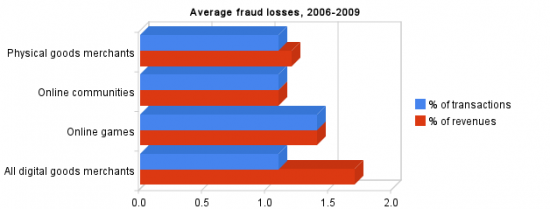A recent Wall Street Journal article proclaimed, Fraudsters Like Virtual Goods: Fast-Growing E-Commerce Segment Seems More Vulnerable to Cyber Criminals based on research from CyberSource Corp., which processes credit cards for online merchants.
The article makes it sound that virtual goods sales are more prone to fraud than physical products. But when we contacted CyberSource, it turns out that the opposite is actually true — virtual goods sold in online communities have the same level of fraud as physical goods, and lower levels of fraud than other types of digital content. Meanwhile, losses reported by online game merchants fall between the two groups.
Part of the problem could be in the way that “virtual goods” are defined. Are they just things like virtual swords in World of Warcraft, virtual gifts sent through Facebook and other social platforms, and virtual clothing on Second Life? Or do they include electronic books, website subscriptions, music downloads, videos, and software?

The broader category — which CyberSource defines as “digital goods” — have higher losses, according to Doug Schwegman, the company’s director of market intelligence. In 2009, digital goods merchants lost 1.9% of their revenues to fraud. By comparison, physical goods merchants lost 1.1% of their revenues to fraud. Averaged over the past four years, digital goods merchants reported 1.7% losses compared to 1.2% for physical goods merchants.
The percentage of fraudulent transactions was the same, however — 1.1% across the board for all categories.
“This would imply that when a digital merchant suffers a fraud loss that the average value of that loss is higher — in percentage terms — than what a physical goods merchant might experience,” Schwegman told Hypergrid Business.
One reason that fraud rates are higher for digital goods is that digital goods are delivered instantaneously through a download, while physical goods have to be shipped to an actual address. If the shipping address doesn’t match the billing address, or there are other red flags, the merchant has time to check that the order is legitimate.
But in virtual environments, the content isn’t simply downloaded to a computer, but delivered inside the virtual community to the community member’s avatar or virtual identity.
According to Schwegman, the merchants surveyed who identified themselves as online communities or associations, had a four-year revenue loss rate of 1.1% — the same as physical goods merchants.
“Perhaps having to register and associate a real world address and identity to a virtual avatar or identity does reduce fraud,” he said.
CyberSource also surveyed online games companies, and here the fraud rate average over the past four years was 1.4% of revenues lost to fraud — higher than physical goods merchants, but lower than the 1.7% average of the entire digital goods category.
“It might be easier to sell a login to a game account or items that are transferrable within a game than other virtual items,” Schwegman said. “That would attract more fraud.”
- International singers gather on Alternate Metaverse Grid for first annual International Day - April 15, 2024
- OpenSim hits new land, user highs - April 15, 2024
- Wolf Territories rolls out speech-to-text to help the hearing impaired - April 15, 2024

